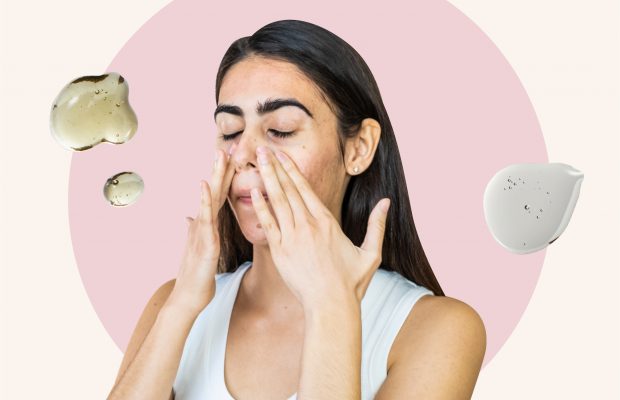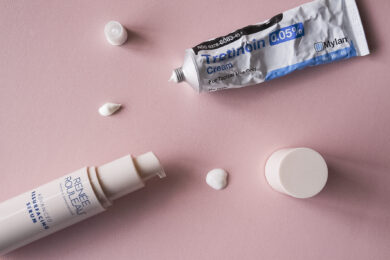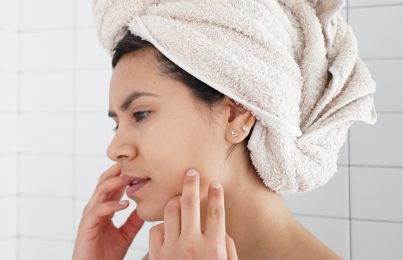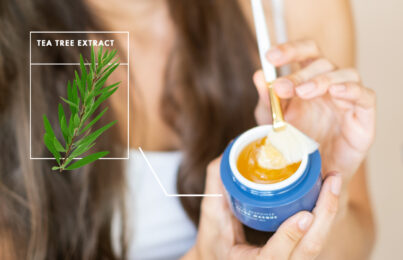Updated 3/12/24. You just started using a new skincare product and now you’re breaking out more than usual. What should you do? How can you tell whether your skin is purging or you’re simply experiencing normal breakouts? Should you wait it out or should you stop using the new product immediately?
It’s not easy to know what’s behind your breakouts, but hopefully, this post will guide you in the right direction. Keep reading to learn everything you need to know about skin purging—what it is, how long it lasts, and what you can do about it!
What Is Skin Purging?
Skin purging is a process that occurs when you start using a new skincare product that increases the rate of cellular turnover. Because your skin cells are turning over more quickly, lingering breakouts that might’ve taken weeks (or even months) to surface all appear at once. This means that, before it gets better, your breakouts can actually get worse. While it may seem unfair, if you stick with the new product and don’t get discouraged through the purging process, you’ll be rewarded with smooth, clear skin.
The most common types of breakouts people experience when their skin purges are whiteheads and pustules. They’re similar in that they both develop pus as a result of infection. However, pustules tend to be more red and inflamed. If you’re prone to hormonal acne, you may also develop cystic blemishes in the purging process.
Read a complete guide to clearing clogged pores.
How Long Does Skin Purging Last?
This is a really difficult question to answer because there is no definitive time period. The length of time your skin purges can depend on a number of things, including how many clogged pores you have to begin with and the strength of the product you started using.
For over-the-counter products, anywhere from 2-6 weeks is a good rule of thumb since it takes the skin about a month to fully turn over. With that being said, if you have a lot of closed comedones (aka clogged pores), it could potentially take longer for your skin to clear up. Think of it this way… Those clogged pores are full of hardened oil, dirt, and debris, and all of that needs to go somewhere, which is why many of them will surface as whiteheads. This is your skin’s way of “resolving” them.
If you’re using a prescription-strength medication, skin purging can sometimes last longer than two to six weeks, especially if your breakouts were severe. In fact, a lot of dermatologists like to wait three months before even scheduling an appointment with a patient after they’ve been prescribed medication. Regardless, it’s important to follow the provider’s instructions and talk to them about what to expect in terms of skin purging. If the skin purging doesn’t improve, they can help you make adjustments (whether that means a stronger prescription or switching to a different medication altogether).
What Kind of Skincare Ingredients Can Cause Purging?
Ironically, the ingredients that typically cause skin purging are also the ones that are best for treating breakouts (weird, right?). As I mentioned before, these are the ingredients that encourage skin cells to turn over in a faster, more efficient way.
Exfoliating Acids
Exfoliating acids remove dead skin cells from the surface of the skin. They can help achieve smooth, clear, and even-toned skin. However, it’s not uncommon to experience some initial breakouts when you begin using them. While any type of exfoliating acid can cause purging, salicylic acid (BHA) is often the main culprit. It’s oil-soluble, so it can penetrate into the pore lining to help loosen hardened oil and clear out clogged pores (think of it as a deep clean for your pores!). While this is great for addressing breakouts, it can definitely lead to purging since all of the gunk in your pores is being pushed out.
As frustrating as it may be, an initial purging period is considered normal when it comes to exfoliating acids—but it’ll all be worth it once you get through to the other side!
What to Do if You Suspect Exfoliating Acids Are Causing Purging
If you suspect an exfoliating acid is causing your skin to purge, stay the course and give it time. Purging from exfoliating acids should start to normalize anywhere from 2-6 weeks time. During that time period, you can try cutting back on the frequency of use. This will slow down the purging process so you aren’t getting as many new blemishes all at once. However, this will also extend the duration of the purge overall.
It’s important to note that, for a small percentage of people, exfoliating acids just won’t agree with their skin. In that case, they’ll have to cut them out altogether. Before you cut them out, though, remember that there are many different kinds of exfoliating acids. Sometimes, it comes down to finding the right one for you. After all, the type of acid, as well as its strength and the quality of formulation all make a difference.
Retinol and Retinoids
Vitamin A, the active ingredient found in retinol and retinoids, also works to increase cell turnover. But unlike exfoliating acids, which perform this function on the surface, vitamin A works deep within the skin’s layers. So, if you have clogged pores, using a vitamin A product can bring them to the surface, resulting in temporary skin purging. What’s more, is that retinol and retinoids can initially make breakouts worse by drying out the skin. Dry skin can trap oil in the pores, resulting in even more breakouts while the skin adjusts.
Keep in mind that retinol and retinoids are not the same. Retinoids are stronger and they’re usually found in prescription medications. Because of this, they typically encourage new breakouts more than retinol does. However, it’s not entirely impossible to experience purging from retinol. (On that note, read my beginner’s guide to retinol and retinoids!)
What to Do if You Suspect Retinol or Retinoids Are Causing Purging
When it comes to retinol and retinoids, it’s super important to introduce them into your routine slowly—especially when it comes to a prescription. Otherwise, you could easily end up with a lot of irritation, which can actually exacerbate breakouts. Because of this, a skin purge from retinol can last upwards of 4-8 weeks. Stay the course and see how it plays out, keeping in mind that it could take even longer if you’re using a prescription retinoid. Vitamin A is a very active ingredient, and in order to achieve positive, long-term change in the skin, you have to be patient!
Benzoyl Peroxide
Benzoyl peroxide is great for unclogging pores and addressing inflammatory breakouts, though it can definitely bring things to the surface for the first few weeks as it breaks up clogged pores. Like retinoids, benzoyl peroxide is a very active ingredient that can be associated with unwanted side effects like dryness, redness, peeling, and even stinging. Once again, you’ll want to introduce it into your routine slowly to avoid irritation (remember, irritation triggers breakouts!).
What to Do if You Suspect Benzoyl Peroxide Is Causing Purging
When it comes to benzoyl peroxide, your breakouts should start to diminish after 2-6 weeks. If you’re experiencing a lot of purging, look at the strength of the benzoyl peroxide you’re using. Percentages can range anywhere from 2.5-10%, and studies have shown lower percentages to be just as effective as higher percentages with fewer side effects. You can also try applying a thin layer of moisturizer to act as a buffer before applying benzoyl peroxide on top. Be sure to bolster the rest of your routine with soothing, hydrating ingredients to avoid negative side effects. If your skin is having a hard time adjusting, there’s nothing wrong with using it just a few nights a week.
Don’t Forget To Give Your Skin A Break
These heavy-hitting active ingredients are great for really driving results, but as with most things, it’s important to practice moderation. If you start to experience uncomfortable tightness, dryness, or visible flaking, I recommend taking a night off from the actives and using Rest Day Masque to restore your moisture barrier. Using Barrier3 technology, this mask forms a protective seal on the skin, providing deep, long-lasting comfort to irritated skin.
Read more about 5 ingredients that will actually repair your skin barrier.
What’s The Difference Between Purging and Breakouts?
To distinguish between purging and breakouts, look at the type of product you started using. If it contains one of the ingredients mentioned above, your skin could be purging. Also, consider the location of your breakouts. Are most of your breakouts in the same areas that they usually appear? If so, your skin could be purging. Finally, keep track of how long it takes your breakouts to diminish. If an over-the-counter product isn’t improving your skin after 2-6 weeks, you may want to stop using it and regroup. When in doubt, it’s always best to consult with a dermatologist or esthetician.
If your skin isn’t purging, there are basically two other reasons a new product could be breaking you out. The first is that a product is causing a bad reaction. Signs of a reaction include redness, itching, stinging, burning, or rashes. Take note of whether or not your skin feels hot to the touch and whether or not clusters of tiny bumps have appeared that make your skin feel rough to the touch (these can be mistaken for breakouts, but it’s actually dermatitis.)
The second reason a new product could be breaking you out is that it’s too heavy for it and it clogs your pores. Avoid heavy products that contain a lot of oils as they may be too occlusive for your skin. If you’re dehydrated, you can try using a heavier moisturizer just a few nights a week until your skin improves. One thing to keep in mind is that products like cleansers, moisturizers, facial oils, hydrating serums, hydrating masks, and sunscreen shouldn’t cause your skin to purge. So if one of these is breaking you out, it just might not be the right one for your skin type.
Other Possible Causes of Breakouts
When breakouts start to increase around the same time we start using a new product, most of us are quick to blame the product. It makes sense, right? While this can definitely be the case, there are so many other factors that may contribute to an increase in breakout activity. Take a moment to consider other possibilities before you give up on your new product. Here are just a few common causes of breakouts.
You’re Using a New Set of Products that You Didn’t Introduce Slowly
This can cause sensitivity and makes it almost impossible to figure out which product you’re reacting to—if any. I recommend that you stop using everything and go back to your regular routine. Then, and only then, slowly add the new products one at a time.
You’re Using the Wrong Foundation
Foundation makeup can most definitely cause bumps, clogged pores, and breakouts. Read my list of the best foundations for oily skin. The foundations on my list are less likely to cause issues.
You’re Not Taking Account of Lifestyle Factors
Take a moment to consider whether any other recent changes could be contributing to an increase in breakouts. These could include changes in diet, travel, stress, and even temperature fluctuations.
The Bottom Line
As you can see, there isn’t a single, easy answer to the question, “Is this new product making my skin purge?” I say this all the time, but it bears repeating… Breakouts are complex, and it can be really difficult to pinpoint their exact cause. With that being said, I hope this helps!
Next, using these skincare ingredients at the same time could be damaging your skin.
Celebrity Esthetician & Skincare Expert
As an esthetician trained in cosmetic chemistry, Renée Rouleau has spent 35 years researching skin, educating her audience, and building an award-winning line of products. Her hands-on experience as an esthetician and trusted skin care expert has created a real-world solution — products that are formulated for nine different types of skin so your face will get exactly what it needs to look and feel its best. Trusted by celebrities, editors, bloggers, and skincare obsessives around the globe, her vast real-world knowledge and constant research are why Marie Claire calls her “the most passionate skin practitioner we know.”




Comments:
Great post! I had no idea that skin purging was a normal part of the process when starting new products. It’s good to know it typically doesn’t last long and that there are ways to manage it. I’ll definitely keep these tips in mind when trying new skincare!
Posted By: Spotymp3 - download now |
This post was really informative! I had no idea that skin purging was a normal part of the skincare process. It’s good to know what to expect if it happens to me. I appreciate the tips on how to manage it too!
Posted By: CharlieTheSteakPlayOnline |
Hi,
I am 30 yrs old. Got acne issues not severe but intermediate from last 2 years after my delivery.
I recently added arbutin (2 times a day) and retinol(once in a week) to my routine and after 10 days of applying my skin started developing small and big acne like comedeons and red painful acne around my cheek. Now it has been around 15 days and they are still active. I didn’t stop using product but confused whether it is not suiting me or my skin is purging I should wait? Please suggest
Posted By: Ankita |
Hi there! Since you are only using the retinol once a week it isn’t enough to make a difference in your skin. If you are prone to cystic and inflamed acne I would suggest skipping the retinol altogether. If you only see congested breakouts try using the retinol three or four times a week. Since you are using the arbutin serum more than 12 fold as often it sounds like this formula isn’t a fit for your skin and likely where these breakouts are stemming from.
Posted By: Renée Rouleau |
I just wanted to thank Renee Rouleau and her team for helping me with my “Maskne”. I’m an RN caring for covid 19 patients and have terrible breakouts that my N95 mask has caused. I’ve been using the Vit. C treatment with the anti bump serum and it is really helping with my painful acne. For anyone wearing a mask at work all day, I highly recommend Renee Rouleau’s products they have been well worth the money.
Posted By: Avree |
Thank you so much for sharing your experience and for all of the work that you do!
Posted By: Ella Stevenson |